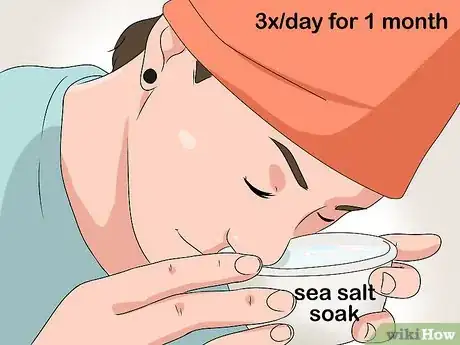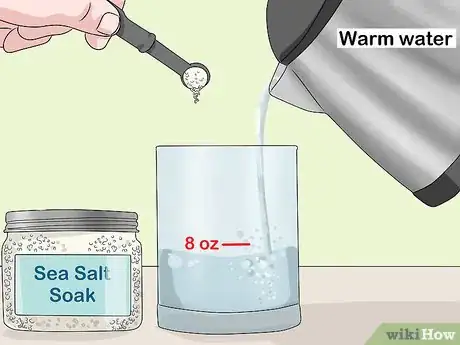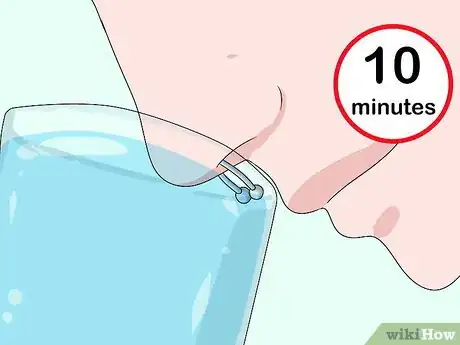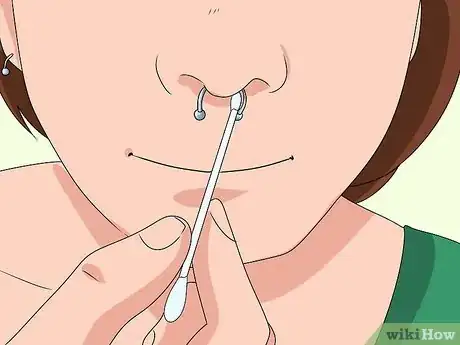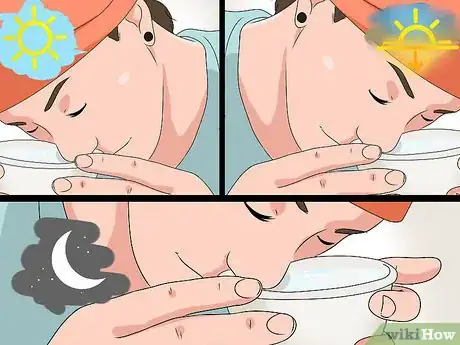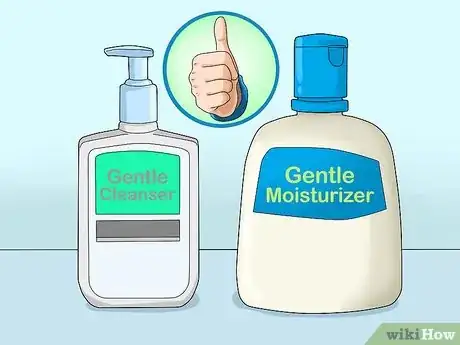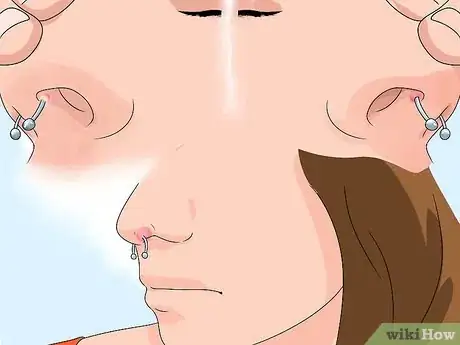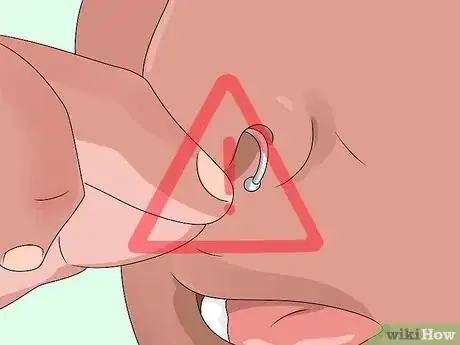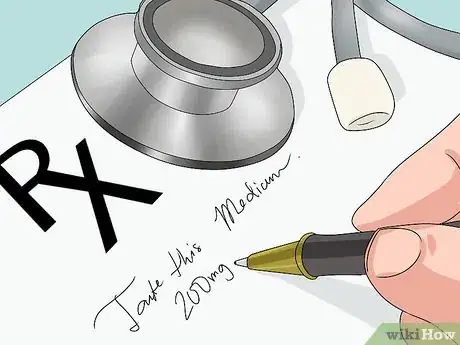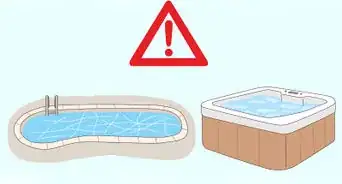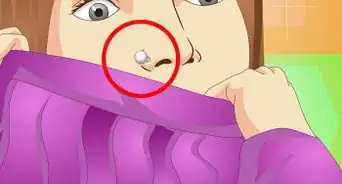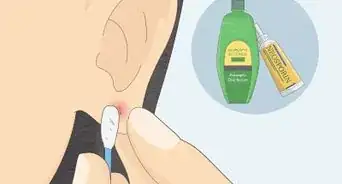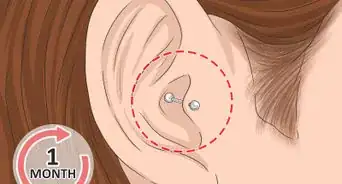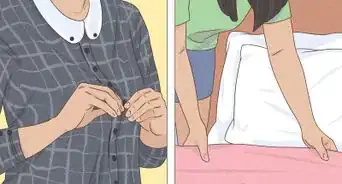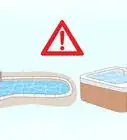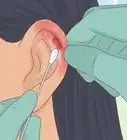This article was co-authored by Karissa Sanford. Karissa Sanford is the Co-owner of Make Me Holey Body Piercing, a piercing studio based in the San Francisco Bay Area that specializes in safe and friendly body piercing. Karissa has over 10 years of piercing experience and is a member of the Association of Professional Piercers (APP).
wikiHow marks an article as reader-approved once it receives enough positive feedback. This article received 14 testimonials and 100% of readers who voted found it helpful, earning it our reader-approved status.
This article has been viewed 610,571 times.
It's always exciting to get a new piercing, but piercings do require some care to stay clean. If you just got a septum piercing, the main cleaning method involves sea salt soaks three times a day.[1] You should also strive to keep the piercing clean by avoiding activities like swimming and only touching the piercing with clean hands. Even with excellent aftercare, infections do happen. If you notice an infection, see a doctor right away for evaluation.
Steps
Doing Regular Sea Salt Soaks
-
1Keep up a cleaning routine for at least a month. While septum piercings take six to eight months to fully heal, you only need to follow a strict cleaning regimen for about a month. During this time, do a sea salt soak three times per day.[2]
- During this time, you should also minimize contact with the piercing and keep creams and makeup away from your face.[3]
-
2Mix your sea salt solution. Fill a glass with about eight ounces of clean tap water. Add about a quarter teaspoon of sea salt. Make sure to use sea salt and not table salt. Mix the solution with a spoon until the salt dissolves.[4]
- Use warm water, as this will help dissolve the salt. Avoid very hot water, as this may be uncomfortable.
Advertisement -
3Soak your piercing in the solution. Soaking a septum piercing can be a little uncomfortable, but it's an important part of the healing process. Dunk your piercing in the solution for five to 10 minutes. If submerging your piercing in water becomes uncomfortable, you can also press a cotton ball saturated with the solution to your piercing for about 10 minutes.[5]
-
4Clean away crust with a q-tip. After soaking your piercing, take a clean q-tip. Dip the end of the q-tip into the piercing solution. Use the q-tip to gently rub away any any crust forming around your piercing.[6]
-
5Soak your piercing three times a day. To keep your piercing clean, soak it around three times a day. Do one soak in the morning, another in the afternoon, and another in the evening. Do not soak your piercing more than three times a day, however, as this can dry it out and increase the risk of complication.[7]
- You can do some of your daily cleaning in the shower by cupping your hands to make a pool of water and then blowing bubbles with your nose in that. You should still make sure to clean with a saline solution at least once a day, though![8]
Keeping the Septum Clean
-
1Avoid touching the piercing. Do not touch the piercing unless it's during the cleaning process. If you do touch the piercing, wash your hands thoroughly first. The less contact your hands make with the piercing, the lower your risk of an infection.[9]
-
2Use gentler products on your face. If you use other products on your face, like moisturizers or face washes, keep them away from the septum piercing as much as possible. You should also use gentler cleansers and moisturizers made with natural ingredients. Avoid using anything with alcohol or peroxide. You should also refrain from using anything scented on your face.[10]
- Avoid these products for about four to six weeks, as this is the length it takes a septum piecing to heal.[11]
-
3Do not swim until your piercing has healed. Stay away from lakes and swimming pools while your piercing is healing. Even chlorine pools have a lot of bacteria that can get int your piercing and cause complications.[12]
- You can begin activities like swimming again after four to six weeks, which is when the piercing will be healed. Once healed, there will be less pain and crustiness around the piercing.[13]
Dealing with Complications
-
1Recognize an infection. Most septum piercings will heal up without a problem if you keep them clean. Unfortunately, however, infections do sometimes happen. The following are signs your piercing has become infected:[14]
- Yellow or green discharge.
- A lump near the piercing.
- Intense pain, redness, or swelling.
-
2Do not remove your jewelry. Your first impulse may be to remove your jewelry if you notice signs of an infection. However, this can actually make the infection worse. If the hole in your piercing closes, this can form an abscess that can have serious medical complications.[15]
-
3See a doctor right away. In the event your piercing becomes infected, make an appointment with a doctor immediately. Infections should not be treated without medical assistance and self-medicating can worsen an infection.[16]
-
4Take any medications your doctor prescribes. Infections are usually treated via topical or oral antibiotics. Take the full round of any antibiotics your doctor prescribes, even after symptoms of an infection have passed. With prompt, proper treatment, a pierced septum infection can be quickly treated.[17]
Community Q&A
-
QuestionI want to get a septum piercing, but I will have to remove it during the day for my job. Will this affect the healing process?
 Community AnswerYou can't take the jewelry out while it's healing, as it will close and you won't be able to get it back in. Tell your piercer you need to hide it for work and they will give you a horseshoe-shaped piece of jewelry that they can flip up and hide. You will need to keep it in for the duration of the healing process.
Community AnswerYou can't take the jewelry out while it's healing, as it will close and you won't be able to get it back in. Tell your piercer you need to hide it for work and they will give you a horseshoe-shaped piece of jewelry that they can flip up and hide. You will need to keep it in for the duration of the healing process. -
QuestionCan I go to the pool on the first day of a piercing?
 Community AnswerIt's not recommended because of the germs in the pool, and the chlorine can irritate the piercing. You should wait until it's fully healed, about six weeks.
Community AnswerIt's not recommended because of the germs in the pool, and the chlorine can irritate the piercing. You should wait until it's fully healed, about six weeks. -
QuestionCan I use Dove soap to clean my septum piercing?
 Community AnswerBecause of the fragrance in most Dove soaps, it is not recommended (unless you use the fragrance-free sensitive skin one). Dial brand antibacterial soap is what's generally recommended with most piercings.
Community AnswerBecause of the fragrance in most Dove soaps, it is not recommended (unless you use the fragrance-free sensitive skin one). Dial brand antibacterial soap is what's generally recommended with most piercings.
References
- ↑ Karissa Sanford. Body Piercing Specialist. Expert Interview 29 October 2019.
- ↑ http://www.skin-artists.com/septum-piercing-healing.htm
- ↑ https://www.painfulpleasures.com/community/blog/client/the-ultimate-guide-to-nose-rings-nose-piercings/
- ↑ https://www.entitymag.com/septum-piercing-what-need-know-before/
- ↑ https://tatring.com/piercing-types/septum-piercing-aftercare
- ↑ Karissa Sanford. Body Piercing Specialist. Expert Interview 29 October 2019.
- ↑ https://www.entitymag.com/septum-piercing-what-need-know-before/
- ↑ Karissa Sanford. Body Piercing Specialist. Expert Interview 29 October 2019.
- ↑ Karissa Sanford. Body Piercing Specialist. Expert Interview 29 October 2019.
- ↑ https://tatring.com/piercing-types/septum-piercing-aftercare
- ↑ https://www.painfulpleasures.com/community/blog/client/the-ultimate-guide-to-nose-rings-nose-piercings/
- ↑ http://www.newhealthadvisor.com/Infected-Septum-Piercing.html
- ↑ https://www.painfulpleasures.com/community/blog/client/the-ultimate-guide-to-nose-rings-nose-piercings/
- ↑ http://www.skin-artists.com/septum-piercing-healing.htm
- ↑ http://www.newhealthadvisor.com/Infected-Septum-Piercing.html
- ↑ http://www.newhealthadvisor.com/Infected-Septum-Piercing.html
- ↑ http://www.newhealthadvisor.com/Infected-Septum-Piercing.html
About This Article
To clean a new septum piercing, do a sea salt soak at least 3 times a day for the first month. Dissolve about ¼ teaspoon (1.4 g) of sea salt in 8 ounces (30 mL) of warm water. Dip your nose into the solution and keep it there for 5-10 minutes. If that’s too uncomfortable, soak a cotton ball in the sea salt solution and hold that against your piercing instead. When you’re done, gently clean any crust away from the piercing with a cotton swab dampened with the sea salt soak. Don’t touch the piercing any more than necessary and use mild skin care products on your face to minimize irritation. Avoid swimming until the piercing is fully healed. If you notice signs of an infection, such as pain, pus, or worsening redness or swelling around the piercing, see your doctor. For more tips, including how to recognize a septum infection and treat it, read on!

